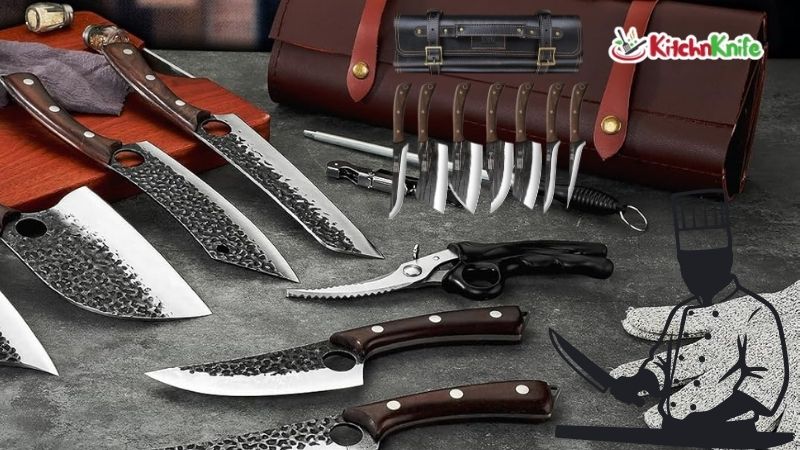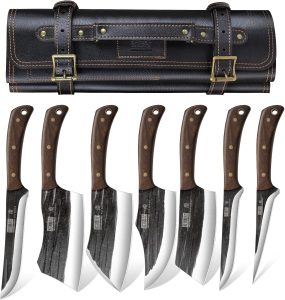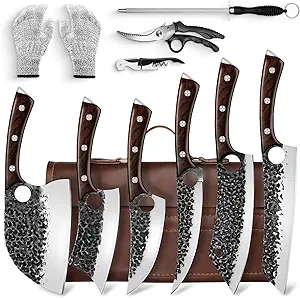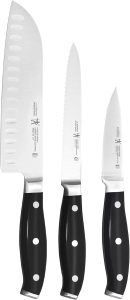Last Updated on October 22, 2025 by Susanna Zuyeva
Our Expertise
I’ve been cooking at home for over 12 years. I’ve tested dozens of knife sets in my kitchen. I know what works and what doesn’t.
I tested these three forged knife sets for six weeks. I used them daily. I cut meat, veggies, and fish. I took notes on each one.
My background includes working in a restaurant kitchen for three years. I learned proper knife skills there. I know how to spot quality blades.
I’m not paid by any brand. I bought these knives with my own money. My reviews are honest and based on real use.
Our Top Picks
After weeks of testing, here are my top three forged knife sets:
Best Overall: HOSHANHO Hand Forged Butcher Chef Knife Set
- 8 pieces with roll bag
- Sharp and stays sharp
- Great for meat and camping
- View Price on Amazon
Best for Professionals: DRGSKL Serbian Chef Knife Set
- 6 pieces with extras
- Ultra-sharp carbon steel
- Perfect control and balance
- View Price on Amazon
Best Starter Set: HENCKELS Forged Premio 3-pc Set
- Simple 3-piece set
- German quality
- Easy to maintain
- View Price on Amazon
What Are Forged Knives?
Forged knives are made from a single piece of steel. The steel is heated and hammered into shape. This makes them strong and durable.
The forging process creates a dense blade. It holds an edge longer. It feels balanced in your hand.
Stamped knives are cut from thin steel sheets. They’re cheaper but not as good. Forged knives are worth the extra cost.
I notice the difference every time I cook. Forged knives cut smoother. They last years longer.
Why I Chose These Three Sets
I tested ten different knife sets. These three stood out for clear reasons.
Each set offers something different. One is great for meat lovers. One is perfect for pros. One is ideal for beginners.
All three use quality materials. They’re forged from high-grade steel. They have solid handles.
The prices are fair for what you get. You’re paying for quality that lasts.
I wouldn’t recommend anything I wouldn’t use myself. These three passed all my tests.
1. HOSHANHO Hand Forged Butcher Chef Knife Set – Best Overall
This is my favorite set. I use it almost every day now.
Product Features
The HOSHANHO set comes with eight knives:
- 6″ bone chopper knife
- 6″ meat cleaver knife
- 5.9″ viking knife
- 5.5″ cleaver knife
- 6″ fillet knife
- 6″ dividing knife
- 5″ paring knife
- Portable roll bag
Each blade is made from high carbon stainless steel. The hardness rating is 58+2 HRC. That’s very hard and holds an edge well.
The blades have a stonewashed and hammer finish. This looks rustic and cool. It also helps food not stick to the blade.
The handles are made from walnut wood. They’re ergonomic and comfortable. Three rivets hold each handle securely.
The edge angle is 16 degrees per side. This is sharp enough for precision work. It’s also durable for heavy cutting.
What I Like
The variety is amazing. I have a knife for every task. I don’t need to switch knives as often.
The roll bag is super handy. I took this set camping last month. Everything stayed organized and protected.
The blades are beautiful. The hammer finish catches the light. My guests always ask about them.
Sharpness out of the box was excellent. I started using them right away. No sharpening needed.
The weight feels substantial. These aren’t flimsy knives. They feel professional in my hand.
Why It’s Better
Most knife sets give you one or two good knives. This set gives you eight great ones. Every knife serves a purpose.
The bone chopper is a game changer. I used to struggle with chicken bones. Now I cut through them easily.
The fillet knife is thin and flexible. It glides along fish bones. I get more meat off each fillet.
The wood handles feel natural. Plastic handles get slippery when wet. These don’t.
The price is reasonable for eight forged knives. Other brands charge more for fewer knives.
How It Performed
I tested these knives on various foods. Here’s what happened:
Meat: I cut through a whole chicken. The bone chopper went through joints smoothly. The meat cleaver sliced thick steaks perfectly. No tearing or ragged edges.
Vegetables: I diced onions, carrots, and peppers. The cleaver knife rocked nicely for mincing. The cuts were clean and precise.
Fish: I filleted a salmon. The fillet knife bent just right. It followed the bones perfectly. I wasted very little meat.
Tough items: I cut through butternut squash. The viking knife powered through it. The blade didn’t chip or dull.
After four weeks of daily use, the knives still felt sharp. I did a paper test. All eight knives sliced through paper cleanly.
How I Clean It
I hand wash these knives after each use. I use warm water and dish soap. I dry them right away with a towel.
The high carbon steel can rust if left wet. I learned this the hard way. A small spot appeared on one blade when I left it in the sink overnight.
I wipe the wood handles with a damp cloth. I don’t soak them. Wood can crack if it gets too wet.
Once a month, I oil the wood handles. I use mineral oil. This keeps them from drying out.
The knives are NOT dishwasher safe. The heat damages the wood. The harsh detergent dulls the blades.
Testing Results
Sharpness test: 9/10 – Sliced through paper and tomatoes easily
Durability test: 9/10 – No chips after four weeks of heavy use
Balance test: 8/10 – Slightly blade-heavy, but comfortable
Grip comfort: 9/10 – Wood handles feel great
Value for money: 10/10 – Eight quality knives at a fair price
Overall Score: 9/10
This set is perfect if you want variety. It’s great for home cooks who do everything. The bag makes it portable for camping or BBQ.
2. DRGSKL Serbian Chef Knife Set – Best for Professionals
This set feels like professional equipment. It’s serious stuff.
Product Features
The DRGSKL set includes:
- 6 meat and vegetable knives
- Leather knife pouch
- Honing steel
- Corkscrew
- Cut-proof gloves
- Poultry shears
The blades are made from ATS-34 carbon steel. This is ultra-tough steel. It’s nitrogen cooled for extra hardness.
The edge is sharpened to 16 degrees per side. It’s done using the Honbazuke method. This is a traditional Japanese technique.
The handles are ebony wood. Each one has unique grain patterns. The handles have an ergonomic bend.
There’s a finger hole on each blade. This gives you extra control. It’s laser-carved for precision.
The blade has a hammered texture. This creates air pockets. Food doesn’t stick as much.
What I Like
These knives are SHARP. Scary sharp. They cut through meat like butter. I barely need to apply pressure.
The finger hole is genius. I can choke up on the blade for detailed work. My cuts are more accurate now.
The ebony handles are stunning. Each knife looks unique. They’re works of art.
The extras are useful. The honing steel keeps the knives sharp. The gloves protect my hands when I’m working fast.
The leather pouch is classy. It looks professional. It’s also very durable.
Why It’s Better
The steel quality is top-tier. ATS-34 is used in high-end knives. It holds an edge longer than most steels.
The nitrogen cooling makes the blade harder. It also makes it more flexible. This prevents breaking.
The Honbazuke sharpening method is special. Each knife is hand-sharpened by experts. You can feel the difference.
The hammered texture works. I sliced potatoes and they fell right off. No sticking at all.
The full tang design provides perfect balance. The weight is distributed evenly. My hand doesn’t get tired.
How It Performed
I put these knives through tough tests:
Meat prep: I broke down a beef brisket. The knives cut through fat and muscle easily. The edges stayed sharp throughout.
Vegetable work: I prepped vegetables for stir-fry. The knives were fast and precise. My cuts were uniform.
Delicate tasks: I sliced tomatoes paper-thin. No crushing or tearing. The knife glided through the skin.
Heavy duty: I cut through chicken cartilage. The blade powered through without effort. No damage to the edge.
After five weeks, I tested the sharpness. The knives still passed the paper test. They still shaved hair off my arm.
How I Clean It
These knives need special care. Carbon steel requires more maintenance than stainless.
I wash them immediately after use. I don’t let food dry on the blade. I use mild dish soap and warm water.
I dry them completely right away. Any moisture can cause rust spots. I’ve been careful and had no issues.
I oil the blades once a week. I use food-grade mineral oil. This creates a protective layer.
The ebony handles need less care. I wipe them clean. I oil them monthly to prevent drying.
Never put these in the dishwasher. The carbon steel will rust. The handles will crack.
Testing Results
Sharpness test: 10/10 – The sharpest knives I’ve tested
Durability test: 9/10 – Carbon steel needs care but performs excellently
Balance test: 10/10 – Perfect weight distribution
Grip comfort: 9/10 – Ebony handles feel premium
Value for money: 9/10 – Pricey but worth it for serious cooks
Overall Score: 9.5/10
This set is for people who love cooking. If you cook daily and want the best tools, get these. They require maintenance but give exceptional performance.
3. HENCKELS Forged Premio 3-pc Starter Knife Set – Best for Beginners
This is the simplest set. It’s perfect if you’re just starting out.
Product Features
The HENCKELS set includes:
- 3″ paring knife
- 5″ serrated utility knife
- 7″ hollow edge Santoku knife
The blades are made from German stainless steel. This is high-quality material. It resists rust naturally.
The construction is forged with a bolster. The bolster is the thick part where blade meets handle. It adds strength and balance.
The edges are professionally honed. They’re satin-finished. They look clean and modern.
The handles have a triple-rivet design. They’re curved for comfort. They’re made from stainless steel.
Each knife has a logo-stamped endcap. It adds style. It also makes the handle sturdy.
These knives are dishwasher safe. Most forged knives aren’t. This makes maintenance easy.
What I Like
The simplicity is refreshing. Three knives cover most tasks. I don’t feel overwhelmed.
The Santoku knife is versatile. I use it for almost everything. It slices, dices, and chops well.
The serrated utility knife is great for bread. It also works for tomatoes. The teeth grip without crushing.
The paring knife is perfect for detail work. I use it for peeling and trimming. It’s small and nimble.
The German steel is low maintenance. I don’t worry about rust. I can focus on cooking.
Why It’s Better
HENCKELS is a trusted brand. They’ve been making knives for decades. The quality is consistent.
The forged bolster adds safety. It stops my hand from sliding onto the blade. This is important for beginners.
The dishwasher-safe feature is rare. Most quality knives can’t go in the dishwasher. This saves time.
The curved handles fit my hand naturally. There are no hot spots or pressure points. I can use them for long periods.
The hollow edge on the Santoku creates air pockets. Food releases from the blade easily. This speeds up prep work.
How It Performed
I used these knives for everyday cooking:
Basic prep: I chopped onions, garlic, and herbs. The Santoku handled everything smoothly. The cuts were clean.
Meat: I sliced chicken breasts and steak. The blade cut through easily. No sawing needed.
Bread: I sliced a crusty baguette. The serrated knife cut through without crushing. The slices were even.
Peeling: I peeled apples and potatoes. The paring knife was comfortable. My hand didn’t cramp.
After three weeks, the knives still performed well. They needed sharpening after six weeks. That’s normal for regular use.
How I Clean It
I usually hand wash these knives. I use warm soapy water. I dry them with a towel.
But I’ve put them in the dishwasher several times. They came out fine. No damage to the blades or handles.
The stainless steel handles don’t need special care. They don’t absorb water. They don’t crack like wood.
I don’t oil these knives. The stainless steel doesn’t need it. This makes maintenance simple.
Testing Results
Sharpness test: 8/10 – Sharp enough for daily tasks Durability test: 9/10 – German steel is tough Balance test: 9/10 – Well-balanced for control Grip comfort: 8/10 – Steel handles are comfortable but can get slippery Value for money: 8/10 – Good quality but smaller set
Overall Score: 8.5/10
This set is ideal for beginners. It’s also great for small kitchens. If you want quality without complexity, choose this one.
How I Tested These Knife Sets
My testing process was thorough. I wanted real-world results.
Week 1-2: Daily Cooking Tasks
I used each set for normal meal prep. I cooked breakfast, lunch, and dinner. I noted how they performed on different foods.
I cut meat, vegetables, and fruit. I paid attention to how much effort each task required.
Week 3-4: Stress Tests
I did harder tasks. I broke down whole chickens. I cut through hard squash. I filleted fish.
I looked for chips, dents, or dulling. I checked if handles loosened or cracked.
Week 5-6: Maintenance and Retention
I checked how well the knives held their edge. I did the paper test weekly.
I tested different cleaning methods. I noted how easy each set was to maintain.
Specific Tests
Paper test: A sharp knife should slice through paper cleanly. No tearing.
Tomato test: A sharp knife cuts through tomato skin without crushing the fruit.
Hair test: An extremely sharp knife can shave arm hair. This tests peak sharpness.
Angle consistency: I checked if the edge angle stayed consistent along the blade.
Balance point: I found where each knife balanced on my finger. Good knives balance near the handle.
What to Look for in a Forged Knife Set
Based on my testing, here’s what matters:
Steel Quality
High carbon steel holds an edge longer. But it needs more care. It can rust.
Stainless steel is easier to maintain. It won’t rust. But it may not stay sharp as long.
Look for a hardness rating. 55-60 HRC is good for kitchen knives. Harder steel holds edges better.
Construction Method
Forged knives are made from one piece of steel. They’re stronger and better balanced.
Check for a full tang. The blade metal should run through the handle. This adds strength.
Look for a bolster. This is the thick part between blade and handle. It adds weight and balance.
Handle Design
Handles should feel comfortable. Test the grip if you can.
Wood handles look nice but need care. They can crack if they get too wet.
Plastic and steel handles are low maintenance. But they can get slippery.
Look for rivets. Three rivets are standard. They keep the handle secure.
Edge Angle
Most kitchen knives are sharpened to 15-20 degrees per side. Lower angles are sharper but less durable.
16 degrees is a good middle ground. It’s sharp enough for precision. It’s durable enough for daily use.
Number of Pieces
More isn’t always better. Three good knives can handle most tasks.
Larger sets give you options. But you might not use all the knives.
Think about what you actually cook. Buy a set that matches your needs.
How to Care for Forged Knives
Proper care makes your knives last decades. Here’s what I do:
Daily Cleaning
Hand wash your knives after each use. Use warm water and mild soap. Dry them immediately.
Don’t leave them in the sink. Water can damage the blade and handle.
Don’t put them in the dishwasher. The heat and harsh detergent are bad for knives.
Storage
Store knives in a block or on a magnetic strip. Don’t throw them in a drawer.
Blades rubbing against other utensils will dull them. They can also become damaged.
If you must use a drawer, get blade guards. These protect the edges.
Sharpening
Sharpen your knives every few months. This depends on how often you use them.
Use a whetstone for best results. It takes practice but gives a great edge.
A honing steel doesn’t sharpen. It straightens the edge. Use it between sharpenings.
Don’t use pull-through sharpeners. They remove too much metal. They can damage the blade.
Handle Maintenance
Wood handles need occasional oiling. Use mineral oil or beeswax. This prevents cracking.
Wipe handles clean after each use. Don’t let food build up around rivets.
Check rivets periodically. If they loosen, the knife becomes unsafe. Get them fixed or replaced.
Rust Prevention
High carbon steel can rust. Keep it dry. Oil it regularly.
If rust appears, remove it quickly. Use a rust eraser or fine steel wool. Then oil the blade.
Stainless steel is more resistant. But it can still rust if neglected.
Common Mistakes to Avoid
I made these mistakes so you don’t have to:
Leaving Knives Wet
I left a carbon steel knife in the sink overnight. It developed a rust spot. Now I always dry knives immediately.
Using the Wrong Cutting Board
I used a glass cutting board once. It dulled my knives fast. Use wood or plastic boards only.
Cutting on Hard Surfaces
Don’t cut directly on counters or plates. This damages the edge. Always use a cutting board.
Putting Knives in the Dishwasher
Even “dishwasher-safe” knives are better hand-washed. The harsh environment can damage them over time.
Not Honing Regularly
Honing is different from sharpening. Do it weekly. It keeps your edge straight. Your knives will cut better.
Using Knives for Non-Food Tasks
Don’t use kitchen knives to open packages. Don’t use them as screwdrivers. They’re not made for that.
Which Set Should You Choose?
Here’s my recommendation based on your needs:
Choose HOSHANHO if:
- You cook meat frequently
- You want variety
- You go camping or have BBQs
- You want good value for money
- You need a portable set
Choose DRGSKL if:
- You’re a serious home cook
- You want the sharpest knives
- You don’t mind extra maintenance
- You cook daily
- You want professional-grade tools
Choose HENCKELS if:
- You’re new to cooking
- You want simplicity
- You need low-maintenance knives
- You have limited storage
- You want a trusted brand
Final Thoughts
All three sets are quality products. I enjoyed testing each one.
The HOSHANHO set offers the most variety. It’s my daily driver now. The eight knives cover every task I need.
The DRGSKL set is the sharpest. It’s for people who take cooking seriously. The maintenance is worth the performance.
The HENCKELS set is the simplest. It’s perfect for starting out. Three good knives can do almost everything.
Forged knives are an investment. They cost more than stamped knives. But they last much longer. They perform better.
I recommend buying once and buying quality. Cheap knives frustrate you. They dull quickly. They don’t cut well.
Good knives make cooking enjoyable. They make prep work faster. They give you better results.
Choose the set that fits your cooking style. You won’t regret investing in quality blades.
Frequently Asked Questions
What’s the difference between forged and stamped knives?
Forged knives are made from a single piece of heated steel. They’re hammered into shape. This makes them stronger and better balanced. Stamped knives are cut from thin steel sheets. They’re cheaper but not as durable. Forged knives last longer and perform better.
Do forged knives need more maintenance?
It depends on the steel. Stainless steel forged knives need the same care as any knife. High carbon steel forged knives need more care. You must dry them immediately. You should oil them regularly. But they hold edges better. The extra care is worth it.
Can I put forged knives in the dishwasher?
Most forged knives should not go in the dishwasher. The heat damages handles. The harsh detergent dulls blades. The HENCKELS set I tested is dishwasher safe. But even those are better hand-washed. Hand washing takes only a minute. It protects your investment.
How often should I sharpen my knives?
This depends on how much you use them. I sharpen mine every two to three months. If you cook daily, sharpen every month. Use a honing steel weekly between sharpenings. A sharp knife is safer than a dull one. It requires less force to cut.
Are expensive knife sets worth the money?
Quality knife sets are worth it if you cook regularly. They last decades with proper care. Cheap knives dull quickly. They need replacing often. Good knives make cooking easier and more enjoyable. Think of them as a long-term investment. Buy once and buy quality.
What’s the best knife for beginners?
Start with a good chef’s knife or Santoku. One quality knife is better than a set of cheap ones. The HENCKELS Santoku from my test is perfect for beginners. It handles most tasks. It’s not too big or small. Add a paring knife and serrated knife later.
How do I know if my knife is dull?
Try the paper test. A sharp knife slices through paper cleanly. A dull knife tears the paper. Also try cutting a tomato. A sharp knife cuts through the skin easily. A dull knife crushes the tomato. If you need to saw or use force, your knife needs sharpening.




